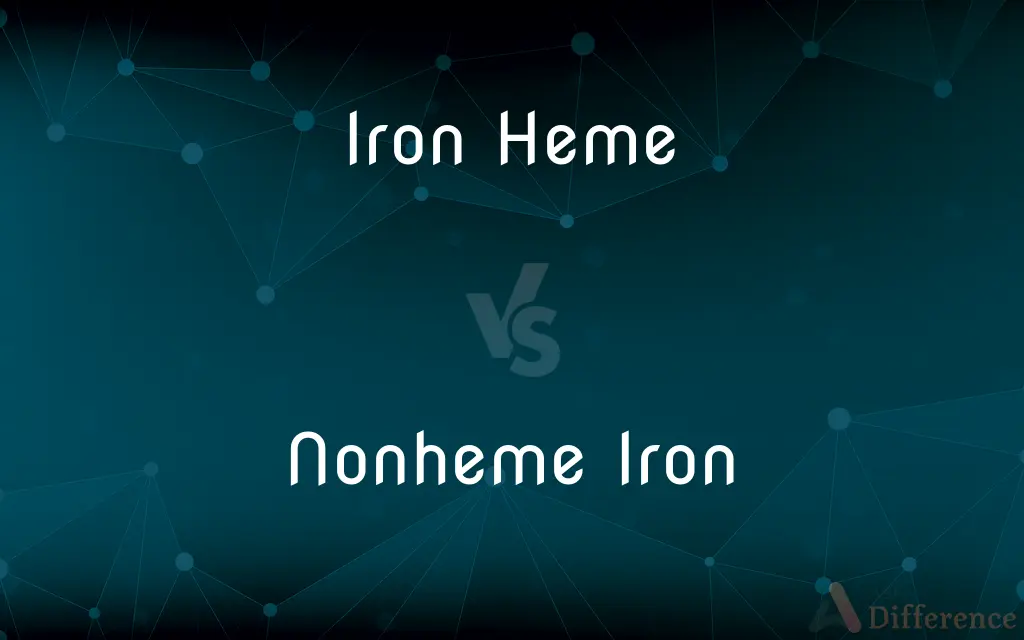Iron Heme vs. Nonheme Iron — What's the Difference?
Edited by Tayyaba Rehman — By Fiza Rafique — Published on December 25, 2023
Iron Heme is the iron component found in hemoglobin and myoglobin. Nonheme Iron is iron from plant-based and other non-animal sources.

Difference Between Iron Heme and Nonheme Iron
Table of Contents
ADVERTISEMENT
Key Differences
Iron Heme and Nonheme Iron are both forms of dietary iron, crucial for many biological functions in humans. However, Iron Heme is primarily derived from hemoglobin and myoglobin in animal tissues. In contrast, Nonheme Iron is predominantly found in plant foods, as well as some animal-derived foods that lack hemoglobin or myoglobin.
The body's absorption mechanisms for Iron Heme and Nonheme Iron are distinctly different. While Iron Heme is absorbed fairly directly and efficiently, the absorption of Nonheme Iron is influenced by various factors, including other dietary components like vitamin C or calcium.
Iron Heme typically contributes a smaller portion of total dietary iron than Nonheme Iron, especially for vegetarians and vegans. However, because of its more direct absorption pathway, the Iron Heme often constitutes a significant portion of the iron actually absorbed by the body. Conversely, while Nonheme Iron is more abundant in most diets, its relative absorption can be lower due to inhibitory or enhancing factors.
Both Iron Heme and Nonheme Iron are vital for maintaining healthy iron levels in the body. An imbalance or deficiency in either form can lead to anemia and other health issues. It's important to incorporate a balance of both in one's diet to ensure optimal health benefits. For those avoiding animal products, enhancing Nonheme Iron absorption becomes essential.
Diverse diets, inclusive of both Iron Heme and Nonheme Iron sources, offer a broad spectrum of nutritional benefits. While Iron Heme sources, like red meats, provide efficient iron uptake, Nonheme Iron sources, such as lentils and spinach, offer other vital nutrients and health benefits.
ADVERTISEMENT
Comparison Chart
Primary Sources
Hemoglobin, myoglobin in animal tissues
Plant foods, some animal foods without hemoglobin
Absorption Mechanism
Direct and efficient
Influenced by other dietary components
Contribution to Diet
Smaller portion but directly absorbed
More abundant but less directly absorbed
Influence on Health
Can lead to health issues if excessively consumed
Essential, especially for vegetarians and vegans
Association with Anemia
Deficiency can lead to anemia
Deficiency can lead to anemia
Compare with Definitions
Iron Heme
The form of iron found in hemoglobin and myoglobin.
Red meat is a rich source of Iron Heme, beneficial for individuals with iron-deficiency anemia.
Nonheme Iron
Iron prevalent in grains, vegetables, and fortified foods.
Cereal often contains added Nonheme Iron to boost nutritional value.
Iron Heme
Iron component associated with oxygen transport in the blood.
Iron Heme plays a critical role in transporting oxygen to tissues.
Nonheme Iron
Dietary iron whose absorption is influenced by other nutrients.
Consuming vitamin C can enhance the absorption of Nonheme Iron.
Iron Heme
The iron type often responsible for the red color of blood.
The bright red hue of blood is due to the presence of Iron Heme.
Nonheme Iron
A type of iron not associated with hemoglobin or myoglobin.
Vegans rely on Nonheme Iron sources for their iron intake.
Iron Heme
A directly absorbed type of dietary iron.
The body can easily utilize Iron Heme from meat sources.
Nonheme Iron
The form of iron most abundant in vegetarian diets.
Nonheme Iron is essential for those avoiding animal products.
Iron Heme
Iron derived from animal tissues.
To boost their iron levels, doctors often recommend consuming more Iron Heme-rich foods.
Nonheme Iron
Iron form primarily found in plant-based foods.
Spinach and beans are excellent sources of Nonheme Iron.
Common Curiosities
Can vegetarians get sufficient iron from Nonheme Iron sources?
Yes, but they may need to consume more and ensure factors that enhance absorption.
Is one form of iron better than the other?
Both forms are important, but Iron Heme is more directly absorbed by the body.
Which foods are rich in Iron Heme?
Foods like red meat, fish, and poultry are high in Iron Heme.
How can I enhance Nonheme Iron absorption?
Consuming vitamin C-rich foods with Nonheme Iron sources can boost absorption.
Can excessive Iron Heme consumption be harmful?
Yes, excessive Iron Heme intake is linked to certain health issues.
Why is Iron Heme critical for our bodies?
Iron Heme plays a key role in oxygen transport in the blood.
Can drinking tea or coffee affect Nonheme Iron absorption?
Yes, they can inhibit the absorption of Nonheme Iron.
Why do some cereals have added Nonheme Iron?
It's to fortify them and provide an additional iron source for consumers.
Do iron supplements contain Iron Heme or Nonheme Iron?
Most iron supplements contain Nonheme Iron forms.
Can one rely solely on Nonheme Iron for iron needs?
While possible, it's essential to ensure enhanced absorption and consume adequate amounts.
How does calcium affect Nonheme Iron absorption?
Calcium can inhibit the absorption of Nonheme Iron.
Are there any medical conditions related to Iron Heme metabolism?
Yes, conditions like hemochromatosis relate to Iron Heme metabolism.
What's the significance of Nonheme Iron in global nutrition?
Nonheme Iron is vital as it's more universally available, especially in plant-based diets prevalent in many parts of the world.
Are there risks associated with low Iron Heme intake?
A deficiency can lead to anemia, but it's crucial to balance intake.
Why is the absorption mechanism different for the two iron forms?
Iron Heme is associated with proteins, allowing direct absorption, while Nonheme Iron's absorption is influenced by dietary factors.
Share Your Discovery

Previous Comparison
SQL Server Developer vs. SQL Server Express
Next Comparison
Piaget Theories vs. Vygotsky TheoriesAuthor Spotlight
Written by
Fiza RafiqueFiza Rafique is a skilled content writer at AskDifference.com, where she meticulously refines and enhances written pieces. Drawing from her vast editorial expertise, Fiza ensures clarity, accuracy, and precision in every article. Passionate about language, she continually seeks to elevate the quality of content for readers worldwide.
Edited by
Tayyaba RehmanTayyaba Rehman is a distinguished writer, currently serving as a primary contributor to askdifference.com. As a researcher in semantics and etymology, Tayyaba's passion for the complexity of languages and their distinctions has found a perfect home on the platform. Tayyaba delves into the intricacies of language, distinguishing between commonly confused words and phrases, thereby providing clarity for readers worldwide.














































